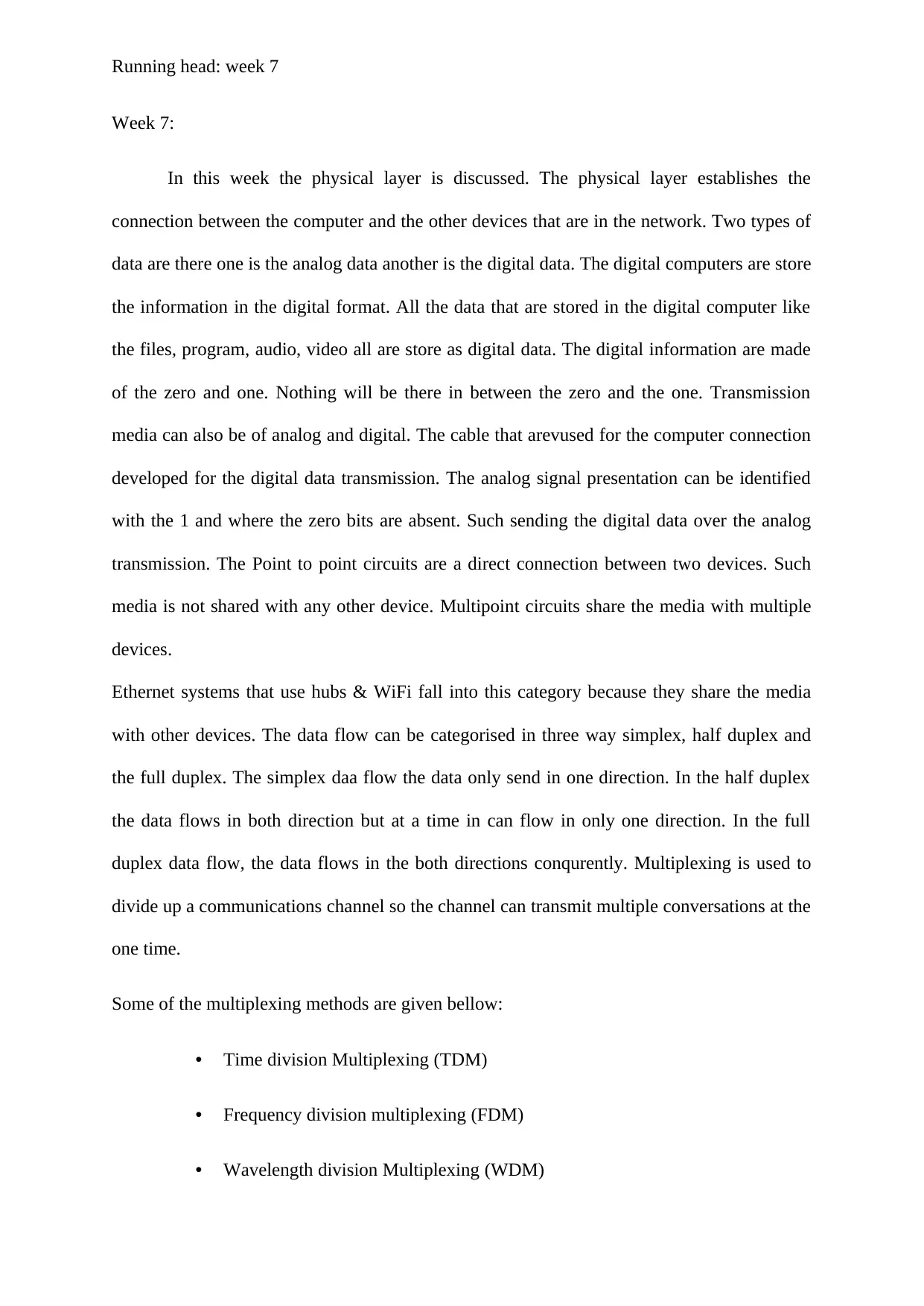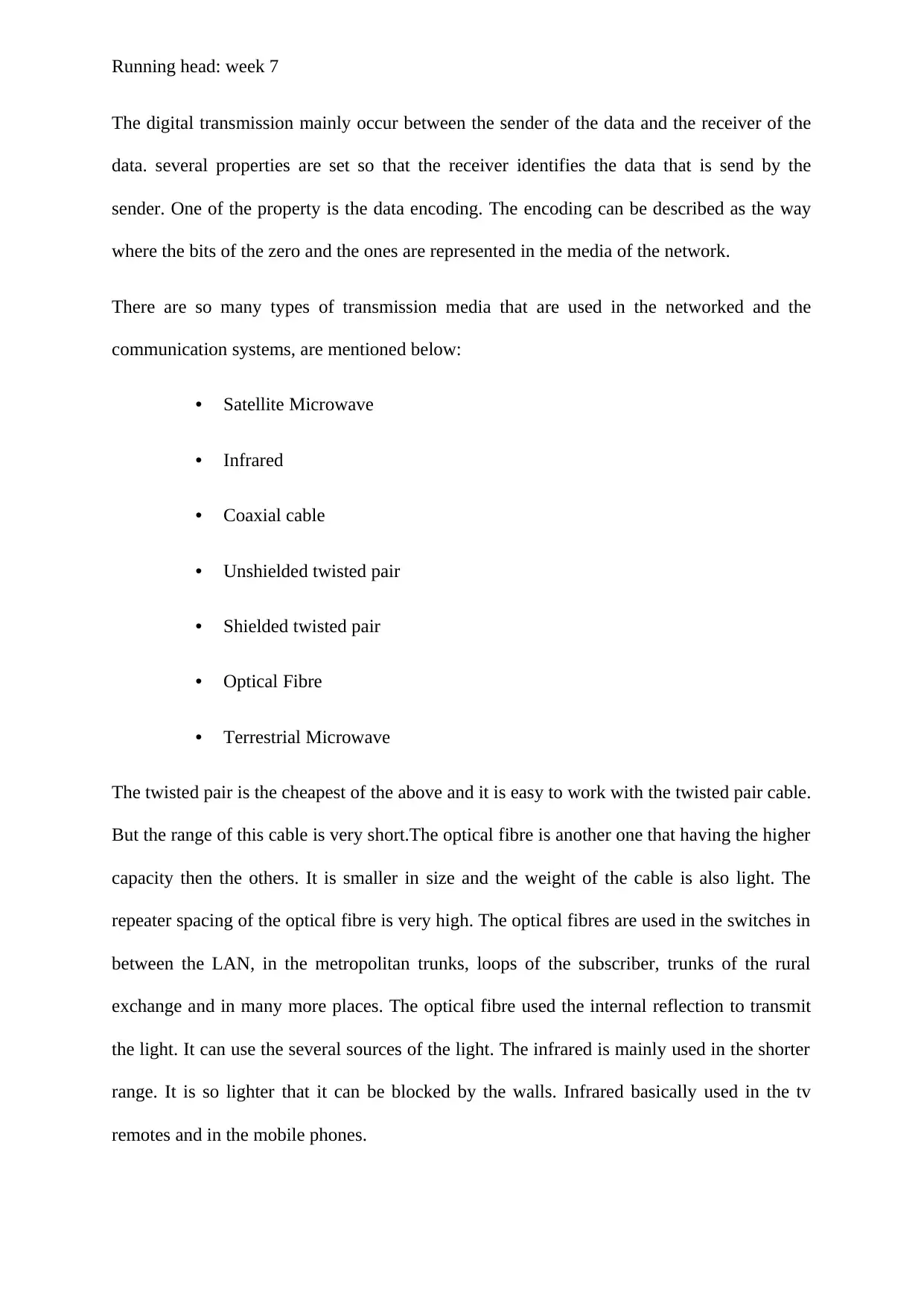ITECH1102 Networking and Security: Week 7 - Physical Layer Analysis
VerifiedAdded on 2023/06/11
|4
|644
|107
Homework Assignment
AI Summary
This assignment solution focuses on the physical layer in networking, covering analog and digital data, point-to-point vs. multipoint circuits, simplex, half-duplex, and full-duplex communications. It discusses multiplexing techniques like FDM, TDM, and WDM, and delves into Manchester encoding. The assignment also explores various transmission media, including twisted pair, coaxial cable, fiber optics, and microwave technologies. The document is available on Desklib, a platform offering study tools and resources for students.

Running head: week 7
The Physical Layer
Name of the Student
Name of the University
Author Note
The Physical Layer
Name of the Student
Name of the University
Author Note
Paraphrase This Document
Need a fresh take? Get an instant paraphrase of this document with our AI Paraphraser

Running head: week 7
Week 7:
In this week the physical layer is discussed. The physical layer establishes the
connection between the computer and the other devices that are in the network. Two types of
data are there one is the analog data another is the digital data. The digital computers are store
the information in the digital format. All the data that are stored in the digital computer like
the files, program, audio, video all are store as digital data. The digital information are made
of the zero and one. Nothing will be there in between the zero and the one. Transmission
media can also be of analog and digital. The cable that arevused for the computer connection
developed for the digital data transmission. The analog signal presentation can be identified
with the 1 and where the zero bits are absent. Such sending the digital data over the analog
transmission. The Point to point circuits are a direct connection between two devices. Such
media is not shared with any other device. Multipoint circuits share the media with multiple
devices.
Ethernet systems that use hubs & WiFi fall into this category because they share the media
with other devices. The data flow can be categorised in three way simplex, half duplex and
the full duplex. The simplex daa flow the data only send in one direction. In the half duplex
the data flows in both direction but at a time in can flow in only one direction. In the full
duplex data flow, the data flows in the both directions conqurently. Multiplexing is used to
divide up a communications channel so the channel can transmit multiple conversations at the
one time.
Some of the multiplexing methods are given bellow:
• Time division Multiplexing (TDM)
• Frequency division multiplexing (FDM)
• Wavelength division Multiplexing (WDM)
Week 7:
In this week the physical layer is discussed. The physical layer establishes the
connection between the computer and the other devices that are in the network. Two types of
data are there one is the analog data another is the digital data. The digital computers are store
the information in the digital format. All the data that are stored in the digital computer like
the files, program, audio, video all are store as digital data. The digital information are made
of the zero and one. Nothing will be there in between the zero and the one. Transmission
media can also be of analog and digital. The cable that arevused for the computer connection
developed for the digital data transmission. The analog signal presentation can be identified
with the 1 and where the zero bits are absent. Such sending the digital data over the analog
transmission. The Point to point circuits are a direct connection between two devices. Such
media is not shared with any other device. Multipoint circuits share the media with multiple
devices.
Ethernet systems that use hubs & WiFi fall into this category because they share the media
with other devices. The data flow can be categorised in three way simplex, half duplex and
the full duplex. The simplex daa flow the data only send in one direction. In the half duplex
the data flows in both direction but at a time in can flow in only one direction. In the full
duplex data flow, the data flows in the both directions conqurently. Multiplexing is used to
divide up a communications channel so the channel can transmit multiple conversations at the
one time.
Some of the multiplexing methods are given bellow:
• Time division Multiplexing (TDM)
• Frequency division multiplexing (FDM)
• Wavelength division Multiplexing (WDM)

Running head: week 7
The digital transmission mainly occur between the sender of the data and the receiver of the
data. several properties are set so that the receiver identifies the data that is send by the
sender. One of the property is the data encoding. The encoding can be described as the way
where the bits of the zero and the ones are represented in the media of the network.
There are so many types of transmission media that are used in the networked and the
communication systems, are mentioned below:
• Satellite Microwave
• Infrared
• Coaxial cable
• Unshielded twisted pair
• Shielded twisted pair
• Optical Fibre
• Terrestrial Microwave
The twisted pair is the cheapest of the above and it is easy to work with the twisted pair cable.
But the range of this cable is very short.The optical fibre is another one that having the higher
capacity then the others. It is smaller in size and the weight of the cable is also light. The
repeater spacing of the optical fibre is very high. The optical fibres are used in the switches in
between the LAN, in the metropolitan trunks, loops of the subscriber, trunks of the rural
exchange and in many more places. The optical fibre used the internal reflection to transmit
the light. It can use the several sources of the light. The infrared is mainly used in the shorter
range. It is so lighter that it can be blocked by the walls. Infrared basically used in the tv
remotes and in the mobile phones.
The digital transmission mainly occur between the sender of the data and the receiver of the
data. several properties are set so that the receiver identifies the data that is send by the
sender. One of the property is the data encoding. The encoding can be described as the way
where the bits of the zero and the ones are represented in the media of the network.
There are so many types of transmission media that are used in the networked and the
communication systems, are mentioned below:
• Satellite Microwave
• Infrared
• Coaxial cable
• Unshielded twisted pair
• Shielded twisted pair
• Optical Fibre
• Terrestrial Microwave
The twisted pair is the cheapest of the above and it is easy to work with the twisted pair cable.
But the range of this cable is very short.The optical fibre is another one that having the higher
capacity then the others. It is smaller in size and the weight of the cable is also light. The
repeater spacing of the optical fibre is very high. The optical fibres are used in the switches in
between the LAN, in the metropolitan trunks, loops of the subscriber, trunks of the rural
exchange and in many more places. The optical fibre used the internal reflection to transmit
the light. It can use the several sources of the light. The infrared is mainly used in the shorter
range. It is so lighter that it can be blocked by the walls. Infrared basically used in the tv
remotes and in the mobile phones.
⊘ This is a preview!⊘
Do you want full access?
Subscribe today to unlock all pages.

Trusted by 1+ million students worldwide

Running head: week 7
1 out of 4
Related Documents
Your All-in-One AI-Powered Toolkit for Academic Success.
+13062052269
info@desklib.com
Available 24*7 on WhatsApp / Email
![[object Object]](/_next/static/media/star-bottom.7253800d.svg)
Unlock your academic potential
Copyright © 2020–2025 A2Z Services. All Rights Reserved. Developed and managed by ZUCOL.





